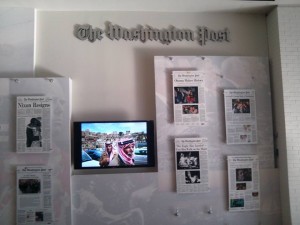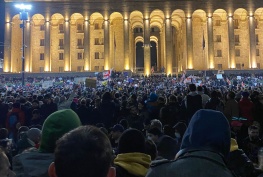HOW THE WASHINGTON POST DOES IT
BY HARRY MISIKO
 This media giant in the heart of Washington, D.C. operates quite differently from my home newsroom at the Nation Media Group in Nairobi, and from Kenyan media in general.
This media giant in the heart of Washington, D.C. operates quite differently from my home newsroom at the Nation Media Group in Nairobi, and from Kenyan media in general.
The Washington Post differs, in general and specifically in its use of technology, how it conducts editorial meetings and how reporters and editors approach assignments:
- Taps and clicks: Most processes and resources at The Post have been digitized. Almost everything is done with the click of the button or a tap on a touch screen.
Documents and instructions have been uploaded to the company’s internal network, called The Source. These include the stylebook, journalists’ code of ethics, staff sitting arrangement, news calendar and notice board, library and archives, and user manuals for the various publishing software.
The Post’s print and online publishing platforms have been merged and use the same software.
But what surprised me on the technological front was the ‘reversed’ roles of a reporter and an editor. Reporters assign gatekeepers stories to review.
Yes!
A writer enters the name of the editor in the story-filing window and the system alerts the gatekeeper of a story awaiting review.
This means less one-on-one interaction between news commanders and their foot soldiers. This saves time.
- Editorial meetings: Editors at The Post hold at least three meetings in a day, where they to review the previous day’s performance, plan ahead and select stories to leadthe print versions. Decisions on the stories to appear on the newspaper’s home page are also made during these meetings.
The difference in their meetings compared to media houses back home is the time taken and how they conduct themselves. Members get seated either before or on time. Most of them come ready to make presentations, give suggestions or critique. The average meeting duration is 10 minutes.
- Assignments and modus operandi: The Post reporters often times come up with story ideas.
Editors hardly assign stories to reporters. News managers’ main duties are to approve, modify or shoot down suggested ideas.
I’ve been particularly impressed with The Post’s power in follow-ups. These guys cover stories from the moment they break and follow them up to their (not only logical) but also possible conclusion.
So long it is still on Earth, they will be on top of it. They can follow up a story for years.
What I have learned is that chasing the flow of particular news can actually give better and bigger stories.
It is not once or twice I have seen follow-ups on stories that began as briefs making it to the first page of the newspaper.
Differences aside, The Post and Nation are similar in several ways, including having both warm and cold staff and managers. In which proportions? That is a story for another day.




